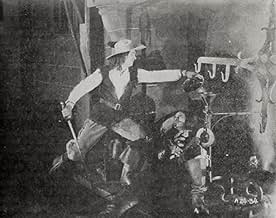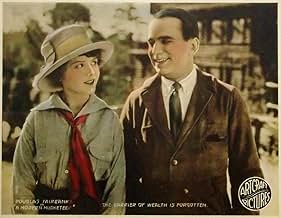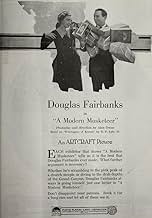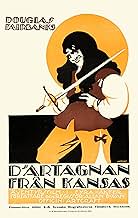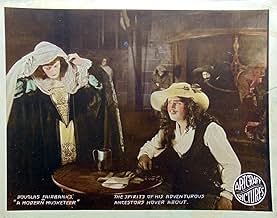Aggiungi una trama nella tua linguaA restless young man travels west, encountering adventure, romance, and danger.A restless young man travels west, encountering adventure, romance, and danger.A restless young man travels west, encountering adventure, romance, and danger.
- Regia
- Sceneggiatura
- Star
Zasu Pitts
- A Kansas Belle
- (non citato nei titoli originali)
Charles Stevens
- Indian
- (non citato nei titoli originali)
Recensioni in evidenza
Turner Classic Movies showed a complete print of "A Modern Musketeer" last night, March 20, 2008. The credit at the end identified the movie as a 2006 Danish Film Archive restoration. TCM added a Monte Alto Orchestra score to the silent. The Danish Archive did a mighty fine job restoring the movie, if the the print had any speckles, fading or snow, I missed seeing them. The miracles of a frame-by-frame computer restoration of a 90+ year old movie.
The movie itself is a showcase for Douglas Fairbanks' acrobatic talents. His playing a role set in the present does not stop him from doing a handstand at the edge of a precipice, getting onto a horse by leaping onto the saddle without using a stirrup (Steve McQueen did that too in his western TV series, but Fairbanks does the leap further from the saddle) and sliding in and out of cut stone windows at every opportunity.
This movie shows that in 1917 Hollywood art directors were on the ball. At the end, the movie's interior action takes place in a set that represents an Anasazi cave dwelling. This cave set sure looks authentic to me. The director Alan Dwan later said that in a Fairbanks movie everything was arranged to make it look as if Fairbanks was not exerting himself as he performed his stunts. So the height of windows in the cave set allow Fairbanks to fly though them. Outside of this set, much of the action seems to take place on the south rim of the Grand Canyon, not far from the El Tovar hotel.
If the El Tovar hotel gave the cast and crew of this movie free or discounted accommodations, I would not be surprised. At every chance, the movie uses vistas of the Grand Canyon as background for the action. The El Tovar hotel must have seen a spike in tourists staying at the hotel after the movie came out, moviegoers who became tourists.
The movie's story is pretty lame. Fairbanks rescues the girl from not one, but two villains. But the story is important only in that it showcases Fairbanks the personality and the stunt man. Thanks to the Danish film archive and TCM, this Fairbanks star vehicle is again available for viewing (when TCM shows it again). ---
Addition (26 July 2009): I finally bought on sale A Modern Musketeer on DVD as part of the Douglas Fairbanks 5 DVD movie box set of the same name. The one thing that stands out for me now is how advanced most of the movie image framing and editing is. For a 1917 movie, you expect and usually get interior scenes that are static with the camera too far from the actors, as if filming a stage play. Even in 1924's The Sea Hawk, the scenes inside the family manor were shot wide a lot, with few medium close-ups. Not in the case in A Modern Musketeer, where director Dwan keeps the camera much closer to the actors, even when the Grand Canyon is the backdrop, varying the shot selection a lot, just like in movies made decades later.
On the commentary track, the film experts mentioned how many scenes in the movie were shot at less than 24 frames per second, adding speed to the action. I did not notice that undercranking when I saw the movie now, but I did notice that Dwan used an awful lot of setups to film the action from different perspectives. One commentator mentioned how good the wide angle chase scene through the wide floor of the canyon (an area now probably flooded by Lake Meade) must have looked when the original, undamaged print was projected on the big screen in the Rivoli Theater in 1917, as first one group of riders, than a second, take off after Fairbanks and company on the run on horseback. Dwan took advantage of the majestic location to make this wide angle shot, which would look at home in a modern Western except for the missing inserts showing close up shots of the riders. But then, Dwan doesn't overdo the editing, no jump cuts for him either.
The commentators mentioned that other filmmakers copied some scenes in the movie, indicating one streetcar scene that Harold Lloyd used and a "cyclone" scene in Kansas with a house falling down that Buster Keaton referred to years later. I think that Dwan's style of editing and framing scenes must have been copied as well. What also stands out for me, though, is how Dwan, with the limited camera technology then available, moved the camera every which way with loads of setups to compensate for the lack of close-up lenses, no use then (as far as I know) of cameras on rails and managing to film those location scenes at the Grand Canyon using orthochromatic film (the last mostly the responsibility of ace cinematographer Hugh McClung).
The movie itself is a showcase for Douglas Fairbanks' acrobatic talents. His playing a role set in the present does not stop him from doing a handstand at the edge of a precipice, getting onto a horse by leaping onto the saddle without using a stirrup (Steve McQueen did that too in his western TV series, but Fairbanks does the leap further from the saddle) and sliding in and out of cut stone windows at every opportunity.
This movie shows that in 1917 Hollywood art directors were on the ball. At the end, the movie's interior action takes place in a set that represents an Anasazi cave dwelling. This cave set sure looks authentic to me. The director Alan Dwan later said that in a Fairbanks movie everything was arranged to make it look as if Fairbanks was not exerting himself as he performed his stunts. So the height of windows in the cave set allow Fairbanks to fly though them. Outside of this set, much of the action seems to take place on the south rim of the Grand Canyon, not far from the El Tovar hotel.
If the El Tovar hotel gave the cast and crew of this movie free or discounted accommodations, I would not be surprised. At every chance, the movie uses vistas of the Grand Canyon as background for the action. The El Tovar hotel must have seen a spike in tourists staying at the hotel after the movie came out, moviegoers who became tourists.
The movie's story is pretty lame. Fairbanks rescues the girl from not one, but two villains. But the story is important only in that it showcases Fairbanks the personality and the stunt man. Thanks to the Danish film archive and TCM, this Fairbanks star vehicle is again available for viewing (when TCM shows it again). ---
Addition (26 July 2009): I finally bought on sale A Modern Musketeer on DVD as part of the Douglas Fairbanks 5 DVD movie box set of the same name. The one thing that stands out for me now is how advanced most of the movie image framing and editing is. For a 1917 movie, you expect and usually get interior scenes that are static with the camera too far from the actors, as if filming a stage play. Even in 1924's The Sea Hawk, the scenes inside the family manor were shot wide a lot, with few medium close-ups. Not in the case in A Modern Musketeer, where director Dwan keeps the camera much closer to the actors, even when the Grand Canyon is the backdrop, varying the shot selection a lot, just like in movies made decades later.
On the commentary track, the film experts mentioned how many scenes in the movie were shot at less than 24 frames per second, adding speed to the action. I did not notice that undercranking when I saw the movie now, but I did notice that Dwan used an awful lot of setups to film the action from different perspectives. One commentator mentioned how good the wide angle chase scene through the wide floor of the canyon (an area now probably flooded by Lake Meade) must have looked when the original, undamaged print was projected on the big screen in the Rivoli Theater in 1917, as first one group of riders, than a second, take off after Fairbanks and company on the run on horseback. Dwan took advantage of the majestic location to make this wide angle shot, which would look at home in a modern Western except for the missing inserts showing close up shots of the riders. But then, Dwan doesn't overdo the editing, no jump cuts for him either.
The commentators mentioned that other filmmakers copied some scenes in the movie, indicating one streetcar scene that Harold Lloyd used and a "cyclone" scene in Kansas with a house falling down that Buster Keaton referred to years later. I think that Dwan's style of editing and framing scenes must have been copied as well. What also stands out for me, though, is how Dwan, with the limited camera technology then available, moved the camera every which way with loads of setups to compensate for the lack of close-up lenses, no use then (as far as I know) of cameras on rails and managing to film those location scenes at the Grand Canyon using orthochromatic film (the last mostly the responsibility of ace cinematographer Hugh McClung).
Douglas Fairbanks' lasting image on the screen is one of a swashbuckling hero whose athletic skills, in which he performed all his stunts, has become unparalleled in cinema. The actor presaged his famous adventurer persona in December 1917's "The Modern Musketeer." This movie marked the first appearance of his sword fighting skills, appearing in a flashback prologue where Fairbanks, to protect the integrity of a woman's handkerchief, takes on all of the tavern's clientele in an action-packed opening scene.
"The Modern Musketeer" also showcases his tremendous physical agility behind a Grand Canyon backdrop. Director Allan Dwan, who wrote the scenario based on "D'Artagnan of Kansas," by E. P. Lyle, Jr., was able to use the canyon grounds just before the area was declared a national park two years later, where the United States Park Service disallowed filming future dramatic movies within its borders. Fairbanks' hand-stand on the edge of a canyon cliff still has modern audiences gasping for breath, as well as an earlier scene where he climbs atop a church steeple.
After a string of highly-praised and enduring comedy Fairbanks films with screenwriter Anita Loos, "The Modern Musketeer" marked the break between the actor and the scriptwriter and her partner's John Emerson's direction. Ms. Loos was offered more money by the Famous Players-Lasky Studio to work for its New York unit rather than Fairbanks' California subsidiary within the same company.
The actor capitalized on his sudden fame by writing a self-help book, "Laugh and Live," in 1917, which emphasizes the power of positive thinking and raising one's confidence through health (food and exercise), business opportunities and social contacts.
"The Modern Musketeer" also showcases his tremendous physical agility behind a Grand Canyon backdrop. Director Allan Dwan, who wrote the scenario based on "D'Artagnan of Kansas," by E. P. Lyle, Jr., was able to use the canyon grounds just before the area was declared a national park two years later, where the United States Park Service disallowed filming future dramatic movies within its borders. Fairbanks' hand-stand on the edge of a canyon cliff still has modern audiences gasping for breath, as well as an earlier scene where he climbs atop a church steeple.
After a string of highly-praised and enduring comedy Fairbanks films with screenwriter Anita Loos, "The Modern Musketeer" marked the break between the actor and the scriptwriter and her partner's John Emerson's direction. Ms. Loos was offered more money by the Famous Players-Lasky Studio to work for its New York unit rather than Fairbanks' California subsidiary within the same company.
The actor capitalized on his sudden fame by writing a self-help book, "Laugh and Live," in 1917, which emphasizes the power of positive thinking and raising one's confidence through health (food and exercise), business opportunities and social contacts.
Boyish adventurer Douglas Fairbanks (as Ned Thacker) imagines himself as an Alexandre Dumas-like "D'Artagnan of Kansas", but local town-folk aren't taken by his chivalrous "Three Musketeers" routine. On the road seeking greener pastures, Mr. Fairbanks meets sweet young Marjorie Daw (as Elsie Dodge). She is promised, however, to middle-aged millionaire Eugene Ormonde (as Forrest Vandeteer). Their love story takes a back seat to Fairbanks' athletic antics, with trusty Tully Marshall (as James Brown) providing his usual good support.
Tully comes in handy when Navajo nasty Frank Campeau (as Chin-de-dah) goes out looking for a "white woman" for sex - of course, she's also Fairbanks' choice for a mate. A Native American Indian, Mr. Campeau greets Fairbanks by saying "How," and ends up with egg on his face. The cast and crew stay at the El Tovar Hotel, with the backdrop of Arizona's "Grand Canyon" providing an exciting location for Fairbanks and company. "A Modern Musketeer" was missing a couple of reels until recently. Now, a full-length restoration is available.
***** A Modern Musketeer (12/30/17) Allan Dwan ~ Douglas Fairbanks, Marjorie Daw, Tully Marshall, Frank Campeau
Tully comes in handy when Navajo nasty Frank Campeau (as Chin-de-dah) goes out looking for a "white woman" for sex - of course, she's also Fairbanks' choice for a mate. A Native American Indian, Mr. Campeau greets Fairbanks by saying "How," and ends up with egg on his face. The cast and crew stay at the El Tovar Hotel, with the backdrop of Arizona's "Grand Canyon" providing an exciting location for Fairbanks and company. "A Modern Musketeer" was missing a couple of reels until recently. Now, a full-length restoration is available.
***** A Modern Musketeer (12/30/17) Allan Dwan ~ Douglas Fairbanks, Marjorie Daw, Tully Marshall, Frank Campeau
'The Modern Musketeer', now complete and restored thanks to the efforts of the Danish Film Archive, is a fun modern adventure film starring the ever smiling Douglas Fairbanks (Snr). The first scenes show our hero as D'Artagnan of the Three Musketeers, swashing a buckle to rescue a young lady's handkerchief, before fast forwarding to modern times where Ned Thacker, his mother obsessed with the Dumas novel, has been brought up to be chivalrous (and rather irritating) where young ladies are concerned.
When Ned decides to leave for the big wide world in his new car - not until after he's climbed the church spire (as you do) - he meets Elsie Dodge, who's being railroaded into marriage with an unpleasant and cheating millionaire. Falling for Elsie he first lets her share his lunch hamper, then saves her from a fate worse than death at the hands of the local Injun (man with teeth necklace who thinks that makes him king).
Great action sequences involving ropes, jumps, and various acrobatics prefigure Fairbanks' later cinematic adventures. Marjorie Daw plays Elsie as the blushing young ingénue, while Tully Marshall pops up as a wronged man out for revenge. Although this film loses its way somewhat - starting as a likable comedy and then becoming a wild west adventure - it wears its years well and is worth a look.
When Ned decides to leave for the big wide world in his new car - not until after he's climbed the church spire (as you do) - he meets Elsie Dodge, who's being railroaded into marriage with an unpleasant and cheating millionaire. Falling for Elsie he first lets her share his lunch hamper, then saves her from a fate worse than death at the hands of the local Injun (man with teeth necklace who thinks that makes him king).
Great action sequences involving ropes, jumps, and various acrobatics prefigure Fairbanks' later cinematic adventures. Marjorie Daw plays Elsie as the blushing young ingénue, while Tully Marshall pops up as a wronged man out for revenge. Although this film loses its way somewhat - starting as a likable comedy and then becoming a wild west adventure - it wears its years well and is worth a look.
DOUGLAS FAIRBANKS was quite the swashbuckler of his era in the 1920s, especially during the time of his biggest triumphs in ROBIN HOOD, THE THIEF OF BAGDAD, THE MARK OF ZORRO and THE BLACK PIRATE.
But this is an early relic from his silent screen career as early as 1917, and, of course, has to be judged by today's standards of film-making for any potential viewers outside of curious film buffs who want to see it.
Fairbanks was athletic and agile enough, but always looked middle-aged, even though here he's only 34. Furthermore, he looked husky rather than trim--unlike his son, Douglas Fairbanks, Jr., a much better looking man. But his physical prowess is amazing. He clambers over fences, cars, horses in a mere jump. He climbs up over anything in his way with the ease of a monkey swinging through trees, exuberantly smiling while he struts his way through whatever impediment is in his way.
And the film itself, for a relic that was filmed in 1917, is in amazingly good condition, fully restored and with a jaunty background score that is not jarring and obtrusive the way so many of the silent film scores were.
The story is really two stories that run concurrently: the D'Artagnan legend is illustrated in a few brief scenes of derring-do with Fairbanks rescuing a damsel in distress. The young Kansas man who desperately wants to leave his provincial roots (in a scene deliriously overplayed by Fairbanks) is also anxious to have a life of adventure and romance, like D'Artagnan. His father and mother give him their blessing and send him on his way--and the rest of the plot is predictable but fun to watch as he finds his own damsel in distress to rescue from a villainous man.
Fun, and thin on plot--but it does move as briskly as Fairbanks himself. Amusing to realize that only twenty years later, his son, Douglas Fairbanks, Jr. would be in a little swashbuckler called THE PRISONER OF ZENDA.
But this is an early relic from his silent screen career as early as 1917, and, of course, has to be judged by today's standards of film-making for any potential viewers outside of curious film buffs who want to see it.
Fairbanks was athletic and agile enough, but always looked middle-aged, even though here he's only 34. Furthermore, he looked husky rather than trim--unlike his son, Douglas Fairbanks, Jr., a much better looking man. But his physical prowess is amazing. He clambers over fences, cars, horses in a mere jump. He climbs up over anything in his way with the ease of a monkey swinging through trees, exuberantly smiling while he struts his way through whatever impediment is in his way.
And the film itself, for a relic that was filmed in 1917, is in amazingly good condition, fully restored and with a jaunty background score that is not jarring and obtrusive the way so many of the silent film scores were.
The story is really two stories that run concurrently: the D'Artagnan legend is illustrated in a few brief scenes of derring-do with Fairbanks rescuing a damsel in distress. The young Kansas man who desperately wants to leave his provincial roots (in a scene deliriously overplayed by Fairbanks) is also anxious to have a life of adventure and romance, like D'Artagnan. His father and mother give him their blessing and send him on his way--and the rest of the plot is predictable but fun to watch as he finds his own damsel in distress to rescue from a villainous man.
Fun, and thin on plot--but it does move as briskly as Fairbanks himself. Amusing to realize that only twenty years later, his son, Douglas Fairbanks, Jr. would be in a little swashbuckler called THE PRISONER OF ZENDA.
Lo sapevi?
- QuizMarjorie Daw and Kathleen Kirkham, daughter and mother, were seven years apart in age. Daw was only 15(!) when this film was made, which means that she was closer in age to the actress playing her mother than she was to the actor playing her leading man (Douglas Fairbanks was 18 years her senior).
- BlooperWhen Chin-de-dah leads Vandeteer and Elsie through the Canyon, the shadows of the cameraman and another crew member are visible on the ground.
- Curiosità sui creditiExcept for Douglas Fairbanks, whose name appears above the title, there is no cast list. Actors are introduced by intertitle cards just before they appear on the screen. The IMDb cast list therefore uses this "order of appearance" sequence.
- Versioni alternativeIn 2006, the Danish Film Institute copyrighted a 68-minute version of this film, with a musical score played by the Mont Alto Orchestra. Additional restoration and music credits stretch the time to 69 minutes.
- ConnessioniReferenced in Charlot - Chaplin (1992)
I più visti
Accedi per valutare e creare un elenco di titoli salvati per ottenere consigli personalizzati
Dettagli
- Tempo di esecuzione1 ora 8 minuti
- Mix di suoni
- Proporzioni
- 1.33 : 1
Contribuisci a questa pagina
Suggerisci una modifica o aggiungi i contenuti mancanti

Divario superiore
By what name was A Modern Musketeer (1917) officially released in Canada in English?
Rispondi
